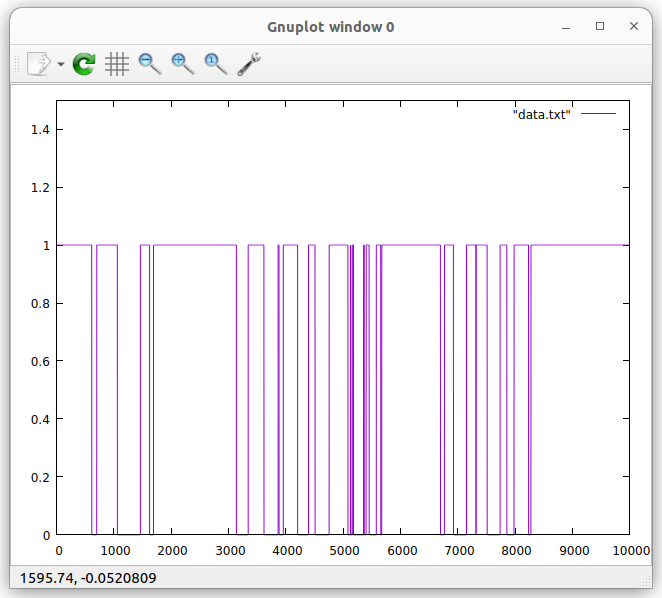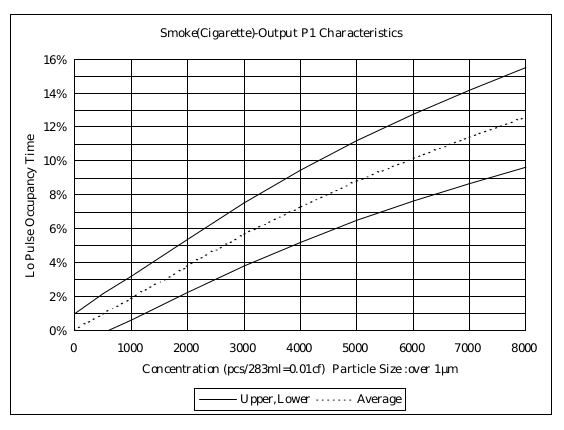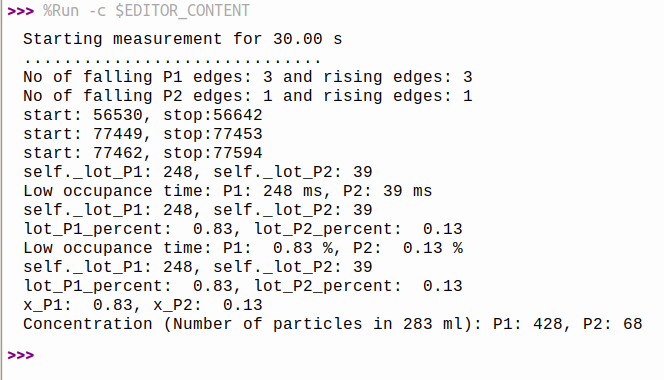The Shinyei PPD42NS sensor
This sensor emits a low occupancy time signal where the relative time the signal is in low state is measured. The connections as are follows:| Shinyei pin | WeMos Pin | GPIO | Comments |
| 1: Common (GND) | GND | ||
| 2: OUTPUT(P2) | D6 | 19 | through voltage divider 5V - 3.3V |
| 3: INPUT(5V DC 90mA) | 5V | ||
| 4: OUTPUT (P1) | D7 | 23 | through voltage divider 5V - 3.3V |
| 5: INPUT T1 | D0 | 26 | DAC |
Reading the signal
To get a feeling about the signals emitted by the Shinyei PPD42NS we first write a very simple program (pulses.py) that reads the P1 data line every 1 ms and saves the result in an array. It does so during 10 s. After data taking, the results are printed on the serial line. We can run the program withampy run pulses.py > data.txtand thus redirect the results into a file that can be plotted with gnuplot.
 The plot shows a measurement where a match has been lighted and the smoke blown into the sensor. The particle concentration can be measured by calculating the relative time the signal is low with respect to the measurement period (low occupancy time).
Shinyei publishes a calibration curve in the data sheet showing the relation between the low occupancy time and the number of particles in 283 ml.
The plot shows a measurement where a match has been lighted and the smoke blown into the sensor. The particle concentration can be measured by calculating the relative time the signal is low with respect to the measurement period (low occupancy time).
Shinyei publishes a calibration curve in the data sheet showing the relation between the low occupancy time and the number of particles in 283 ml.

The driver
The shinyei.py driver is implemented as a MicroPython module. It has the following methods:- __init__(self,P1=23,P2=19,debug=False) : creates a Shinyei object.
P1 is the GPIO pin to which the P1 output is connected
P2 is the GPIO pin to which the P2 output is connected
debug allows to switch on debugging messages - set_debug and get_debug: writes and reads the debugging flag
- measure: starts a measurement. Interrupts are enabled on both P1 and P2 and connected to the interrupt handlers edges_P1 and edges_P2
The interrupt handlers save the moment in time when the signal falls (starts_P1/P2) and when it rises again (stops_P1/P2). - start_stop_times: allows reading the start and stop times
- lot: calculates the difference between stop and start times and sums them (low occupancy time)
- lot_per_cent: calculates the percentage of time the signal was low during the measurement period
- concentration: uses the calibration function to calculate the dust particle concentration
 --
-- Comments
Ideas, requests, problems regarding TWiki? Send feedback



